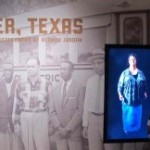
"Jasper, Texas: The Community Photographs of Alonzo Jordan" - exhibition view of show at the ICP in New York
The first thing that came to mind when I heard about the Jasper, Texas: The Community Photographs of Alonzo Jordan, on view at the ICP, was the film “Two Towns of Jasper,” a documentary about the 1998 racially-motivated murder of James Byrd Jr. in Jasper, Texas which I saw at Sundance in 2002. The film’s brilliance was in having two directors – Marco Williams, black, who focused on the story from the African American subjects; and Whitny Dow, white, who did the same from the white side of town. When white Jasper spoke of James Byrd they painted a picture of a social outcast, down and out, drunkard. However, Black Jasper spoke about the man James Byrd – who was lynched – as a brother, friend, cousin, classmate.
So, I was very interested in this Black community and how it lived and saw itself, and pictured itself through the lens of an African American photographer, Alonzo Jordan – who was also a barber, a deacon and a Mason, too. He photographed the everyday special events of his community for three decades. His importance in the community as a photographer was central to the exhibition currently on view at the International Center of Photography through May 8, 2011, and organized by guest curator Alan Govenar. You first encounter Jordon’s work in the iconic image of men by a bus, standing next to a life-size video installation of people from Jordon’s community. Standing in limbo, these full-body testimonials are reminiscent of portraits from… Yet, They speak directly to us. We see and hear Jordan’s wife, his patrons, grand-kids, friends, neighbors share their memories of his love for his work, his process, his dedication to community and his character.
Once inside the exhibition, we are immersed in the world and history of Colored Jasper. Familiar images of church gatherings, weddings, social events, sports event, parades, and other communal rituals cousin us. It is beautiful, it is comfortable, it is familiar. And yet we know that there is an ever-present danger of violence and erasure, underscored by the images of smiling and hopeful high school class portraits, the center image of which is of a young James Byrd.
Black photographers like Jordon documented African American communities and families all across the country since the invention of photography. This was extensively documented in Deborah Willis’s ground-breaking book Reflections in Black: Black Photographers from 1840 to the Present. We are currently making a film inspired by this hidden history of Black Photographers. Our community engagement site Digital Diaspora Family Reunion also reveals ‘hidden histories’ of African American and African Diasporic families through their photographic archives which are the result of professional studio images as well as snap shots. It is in looking at these images by Jordan, and other lesser-known Black photographers, that we not only begin to get a fuller picture of WHO WE ARE, but the power of the act of documenting ourselves and affirming our humanity even in the face of adverse and dehumanizing conditions.

No comments yet.